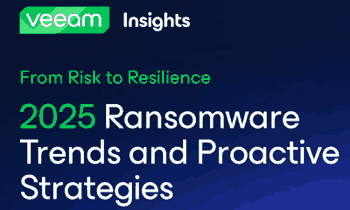Veeam Software, Inc. has released a new report titled From Risk to Resilience: Veeam 2025 Ransomware Trends and Proactive Strategies Report, highlighting the ongoing challenges in managing ransomware threats. This research involved a survey of 1,300 organizations aimed at understanding the recovery strategies of Chief Information Security Officers (CISOs), security professionals, and IT leaders against growing cyber threats.
Ransomware Threats: Current Landscape
The report indicates that ransomware attacks have become more sophisticated, affecting 69% of organizations in the past year, down from 75%. While this decrease is encouraging, it is attributed to improved resilience practices and better collaboration between IT and security teams. Nonetheless, the increasing frequency of attacks from established groups and independent hackers necessitates proactive security measures.
Impact of Ransomware and Recovery Challenges
Despite improved defenses, 70% of organizations reported experiencing at least one cyberattack in the previous year. Alarmingly, only 10% of these organizations managed to recover more than 90% of their data post-attack. Furthermore, 57% of organizations were only able to recover less than half of their data. This illustrates the persistent threat that ransomware poses and the need for comprehensive recovery strategies.
Key Insights from the Report
- Adapting to Law Enforcement Efforts: Coordinated actions by law enforcement have disrupted major ransomware groups, yet smaller teams and solo attackers are on the rise.
- Rise of Data Exfiltration Attacks: Cybercriminals are increasingly focusing on stealing data without encrypting it, targeting sensitive information that can be transferred outside organizations.
- Decrease in Ransom Payments: The aggregate value of ransom payments dropped in 2024, with 36% of affected organizations choosing not to pay. Among those who did pay, many paid significantly less than the initial demands.
- Emerging Legal Consequences: New regulations are being introduced to discourage ransom payments, promoting stronger defenses instead.
- Enhanced Collaboration: Increased communication between IT and security teams and collaboration with law enforcement has proven effective in strengthening defenses.
- Need for Greater Security Investment: While budgets for security and recovery are growing, there remains a significant gap considering the magnitude of the threats.
Importance of Data Resilience
The report emphasizes that organizations prioritizing data resilience can recover from attacks up to seven times faster and sustain lower data loss rates. Those that successfully navigate ransomware events typically implement robust backup and recovery systems, proactive security postures, and have well-established incident response plans. Additionally, organizations are encouraged to adopt the 3-2-1-1-0 rule for data resilience, which includes maintaining immutable backups that are malware-free prior to restoration.
Preparedness and Need for Systematic Training
Interestingly, while 69% of ransomware victims felt prepared before an attack, their confidence plummeted significantly post-incident. The findings show that although 98% of organizations had a ransomware response plan, fewer than half included critical elements such as backup verification and defined communication protocols during incidents. Notably, CISOs exhibited greater awareness of their organization’s security posture compared to CIOs, who reported a larger decline in preparedness after undergoing an attack.
Overall, the research underscores the necessity for organizations to enhance their cyber resilience strategies, emphasizing continuous training and coordination across teams to improve response initiatives during cyber threats.
Resource: Veeam 2025 Ransomware Trends and Proactive Strategies Report (registration required)
About the Report: The Veeam report surveyed 1,300 organizations, of which 900 experienced ransomware incidents involving either encryption or data exfiltration in the past 12 months. Respondents included CISOs and equivalent executives along with security and IT professionals across the Americas, Europe, and Australia.

